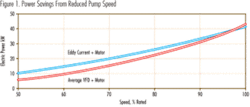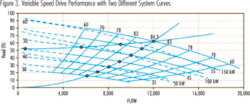When Should Variable Speed Drives be used to Save Energy?
By Allan R. Budris
The use of variable speed drives, especially variable frequency drives, to power industrial and municipal pumps has been growing at a rate of 5 percent a year. Five percent of all motors are VFD controlled, 20% for higher power motors. This growth is driven by the fact that up to 18% of the energy used to drive motors could be saved by applying efficiency technologies, such as VFDs. Motors account for 70% of all electricity used in the U.S.
However even with this attractive energy savings potential, variable speed drives (VSD), such as variable frequency drives (VFD), cannot be justified for many applications, especially on existing installations. During an energy audit at one major manufacturer’s plant, the writer was only able to justify changing to variable speed drives on two of the 110 existing large pumps evaluated.
The biggest reason for applying a VSD is the potential to drastically cut energy costs. This savings is based on what is called the “Affinity Laws” that dictate how pump performance varies with speed. These laws are as follows:
Q 2 = Q 1 * (N 2 / N 1)
H 2 = H 1 * (N 2 / N 1) 2
BHP 2 = BHP 1 * (N 2 / N 1) 3
Where:
Q 1 = The original pump flow rate at speed N 1
Q 2 = The new pump flow rate at speed N 2
H 1 = The original developed pump head at speed N 1
H 2 = The new developed pump head at speed N 2
BHP 1 = The original pump input power at speed N 1
BHP 2 = The new pump input power at speed N 2<
As can be seen from these formulas, pump input power changes as the cube of the change in speed, so a relatively small change in speed will result in a large change of input power (energy). A 20% reduction in speed will, therefore, reduce the pump input power by 51% (see figure 1). So why couldn’t the writer justify VFDs for more than 2% of the existing applications evaluated, instead of the other the options selected (as listed in my September 2007 column), such as impeller trims?
- One key factor is the high cost of Variable Frequency Drives (VFD), further aggravated by the potential requirement to also replace the motor, and address any special cable or impedance load reactor requirements (when the motor lead length exceeds 30–100 ft.), which further increases the cost of the retrofit. For 440 volt motors and above, the heating effect on the motor due to the non–sinusoidal wave forms from the drive (see figure 2), normally requires that standard motors be replaced with VFD rated motors.
- VFD drives can generate stray motor currents. This may require grounding of the motor rotor and/or the use of a bearing with an insulating coating on the outer ring. Small electric discharges between the rolling elements and the bearing raceway can eventually damage (pit) the bearings, and/or cause them to run hotter, especially with larger motors (over 150 hp).
- Not all of this horsepower difference is savings, because a variable–speed device has its own losses. The efficiency of a Variable Frequency Drive (inverter) is affected by operating speed, ranging from about 97% at 100% of rated speed to around 91% at 50% of rated speed (input frequency), for the latest generation of drives. There are also additional losses in the motor due to the movement of the motor duty point. The total VFD/motor efficiency drop can range from 65% to 83% at 40% of rated speed, to 97% at 100% of rated speed, depending on the type of voltage control.
- Another major reason for not selecting a VSD is that system operation may not allow very much speed reduction, which would limit the actual energy saved, especially when the drive efficiency is considered. The amount of actual energy savings from a VSD heavily depends on the shape of the system head–capacity curve (see figure 3). Remember, with a VSD, the pump will always follow the system curve. If the primary component of the system curve is friction loss, very large energy savings can be achieved from large speed changes, plus it also maintains optimum pump efficiency. However, when the system has a large static head component, not only is there less speed (and power) reduction, but the pump is also pushed back to lower efficiencies.
- If the system flow requirements do not change substantially over time, an impeller trim would probably yield a much better return for a much smaller capital investment.
- Finally, Variable Speed Drives are hard to justify when pumps do not operate many hours during the day or year.
The way determine if your application is a good candidate for a VSD/VFD is to perform a detailed financial analysis, comparing the current cost with the cost / pay–back for various options, including a VFD, trimmed impeller, reconditioning of the pump, plus any other option that makes financial sense for the application. The writer’s January 2008 column (“How To Accurately Determine The Magnitude Of Potential Energy Savings From Pumps And Pumping Systems”) provides details and formulas for such an analysis.
On the other hand some installations can take advantage of the possible savings in power consumption provided by variable speed operation. In addition to the large potential energy savings from VFDs, they also offer many other benefits.
- The resulting lower operating speed can increase the life of the pump.
- They eliminate the control valve (and associated losses), starter and any by–pass lines. They are easy to retrofit.
- They generate higher supply side power factors at all loads, unlike a constant speed motor.
- They eliminate the inrush current on start up. Soft starting reduces the stress on the motor, pump, coupling and the supply network.
- They can provide system control logic, fault protection and diagnostics.
- They can restart a spinning load.
- They can enhance the quality of the product pumped.
As can be seen from the above, there is great potential for large cost savings and other benefits from the use of variable speed drives in drinking water and waste water pumping systems. However, it may not make financial business sense for many existing applications. Only a detail analysis can determine if a VFD is right for a particular application.
About the Author:
Allan R. Budris, P.E., is an independent consulting engineer who specializes in training, failure analysis, troubleshooting, reliability, efficiency audits and litigation support on pumps and pumping systems. With offices in Washington, NJ, he can be contacted via e–mail at [email protected].




